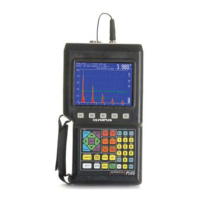170
EPOCH 4PLUS
Reference Reflector A reflector of known size (geometry) at a known
distance, such as a flat-bottom hole.
Refraction, Angle of The angle of sound reflection in the wedge which is
equal to the angle of incidence (also in the wedge.) The
angle of reflectance is measured from the normal to the
reflected sound beam.
Registration The minimum detectable flaw size.
Reject (Control) Also known as suppression, it limits the input
sensitivity of the amplifier in the receiver. “Grass” or
scattering noise can be reduced or eliminated from the
screen by its use. On most analog instruments it also
destroys the vertical linearity relationship between
echo heights.
Resolution The ability of the test system (instrument and
transducer) to distinguish reflectors at slightly
different depths.
Scanning Level The number of dB’s of calibrated gain above the
reference level added to insure seeing potentially
significant reflectors at the end of the V-path in a weld
inspection.
Second Critical Angle The minimum incident angle in the first medium at
which the refracted shear wave leaves the body of the
test specimen.
Sensitivity The ability of the test system (instrument and
transducer) to detect a given size reflector at a given
distance.
Signal-to-Noise Ratio The ratio of amplitudes and indications from the
smallest defect considered significant and those
caused by random factors, such as grain scattering or
instrument noise.
Single Element Probe A probe containing only one piezoelectric element,
which is used to both transmit and receive sound.
Skip-Distance In angle beam testing, the surface distance which
represents one V-path of sound in the material.
Sound Beam The characteristic shape of the ultrasonic wave sent
into the material.
Term Definition

